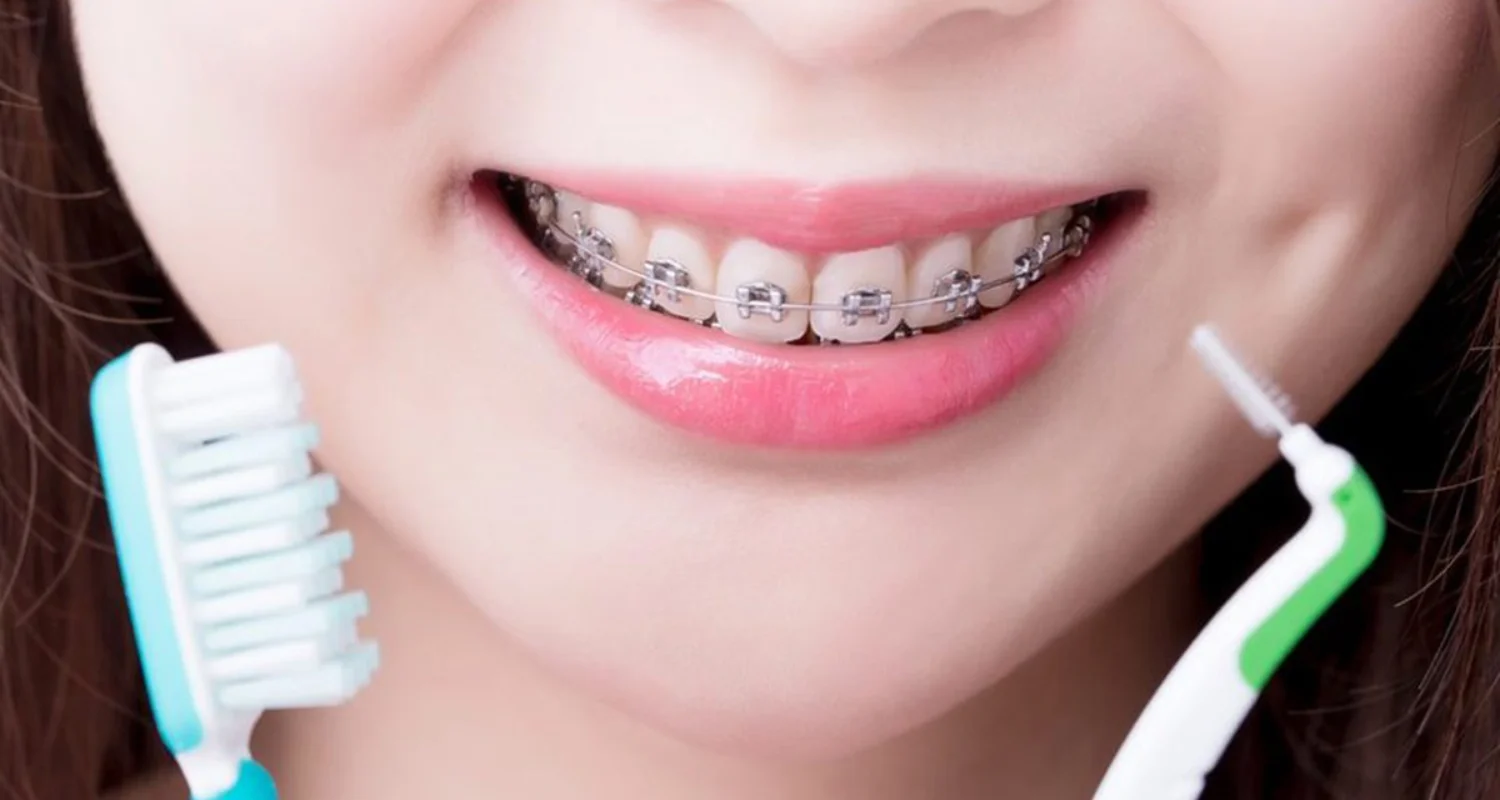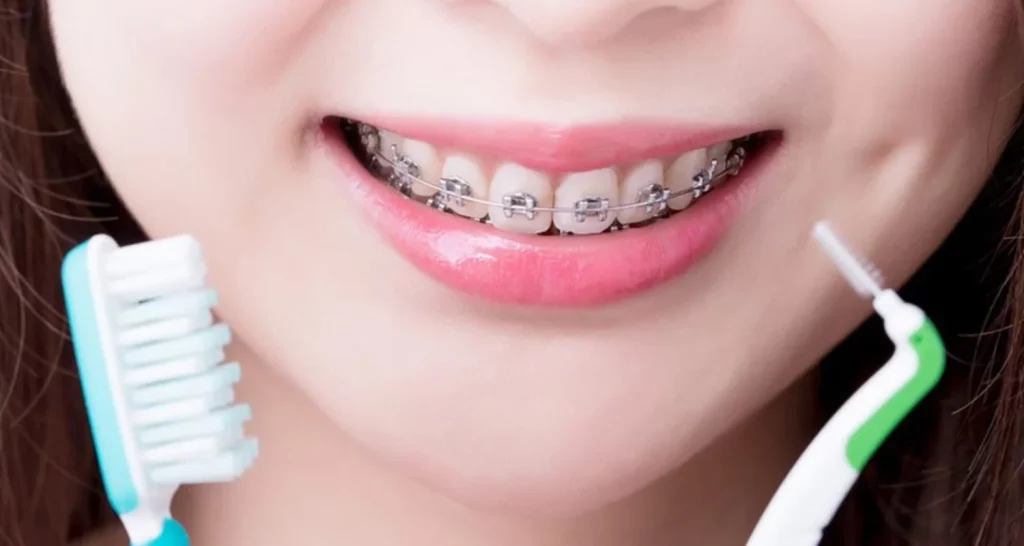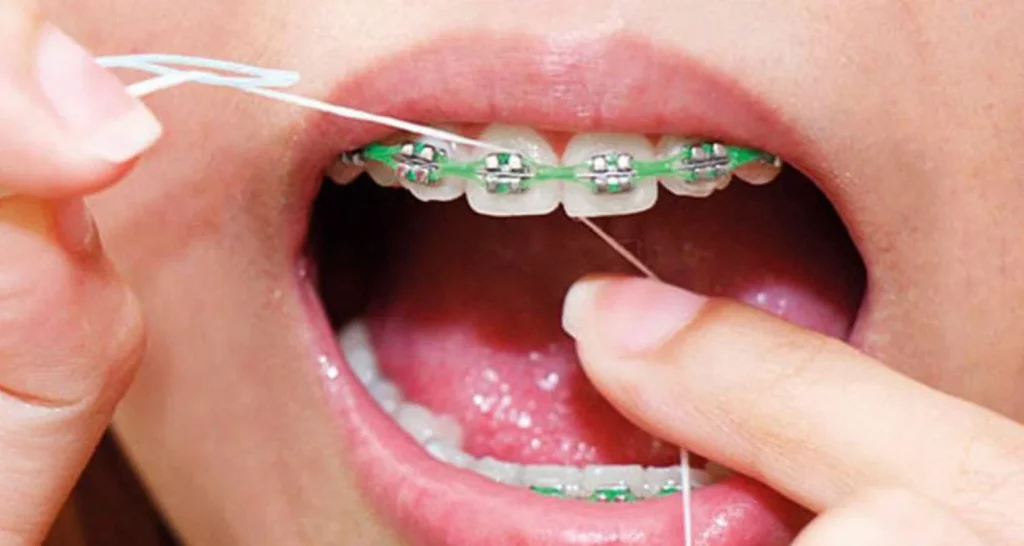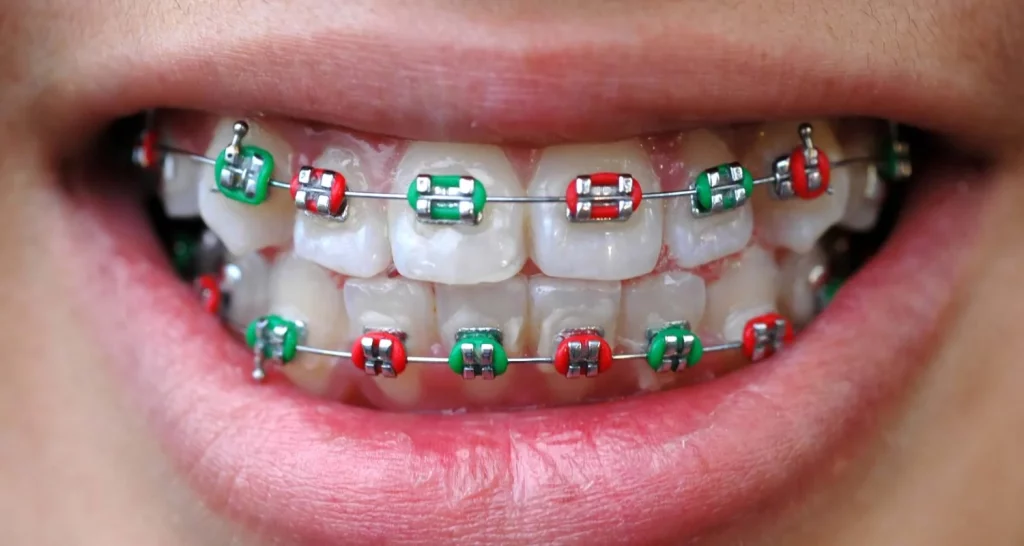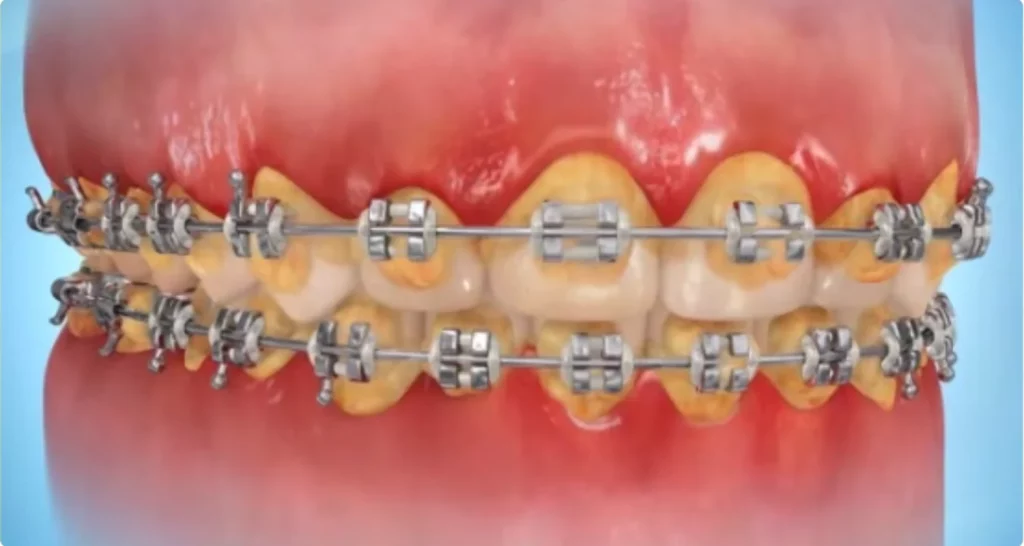Last Updated on: 20th December 2025, 07:49 am
To brush your teeth with braces, use a soft-bristle or electric toothbrush, angle it at 45°, clean around brackets with small circular motions, floss daily with special tools, and finish with mouthwash to prevent plaque and gum issues.
How to Brush Your Teeth with Braces?
Maintaining correct oral hygiene is essential, even more so when braces are present. Proper brushing with braces not only prevents dental problems but also ensures the effectiveness of orthodontic treatment.
Here’s a detailed guide to optimizing your brushing routine:
1. Start brushing: Start with the front part of the teeth, the part visible when you smile. Tilt the brush at 45° to the gum and distribute the toothpaste evenly. Brush gently to cover each tooth completely.
2. Brushing the lower teeth: Close your mouth slightly and brush your bottom teeth in a sweeping motion from back to front. Don’t forget to reach the molars and use gentle movements to avoid damaging the brackets.
3. Brushing the upper teeth: Keeping your teeth closed, use gentle circular motions. Brush the outside of your front teeth and molars, opening your mouth a little if necessary to reach the toughest areas.
4. Using a traditional brush: If you use a regular toothbrush, move the bristles toward your gum lines and the tops of your teeth. This helps remove food particles and plaque that build up around braces.
5. Bracket brushing: Use small circular motions to clean around the brackets. Spend enough time on each tooth segment, and consider using an interdental brush for more difficult areas.
6. Brushing the Inner face of the teeth: Move the toothbrush back and forth, up and down, and in a circular motion on the inside of your upper and lower teeth. When you have braces, this part seems easier to brush since they are located on the outer or front side of the teeth.
Brushing dental crowns Orient your brush perpendicular to the spaces between teeth. Rub the brush from side to side and in a circular motion. This facilitates the removal of soft plaque that adheres to the brackets and in the interdental areas.
7. Thorough cleaning including other areas of the mouth: Your mouth harbors germs and plaque that contribute to the formation of gingivitis. It is important to brush and massage the gums, cheeks, and tongue. Spit if necessary before starting. With the brush, begin to gently brush the gums above (or below) the teeth, with gentle, vertical movements in the direction of the bracket supports. Then, place the brush at a 180° angle to your cheeks and massage gently, avoiding doing it abruptly or hastily. Turn the brush downward and brush the soft bottom and gums, where your tongue rests. Next, brush your palate.
8. Last step: mirror check: The last step is to make sure in a mirror that there is no food remaining on any teeth with braces. If you detect any, use an interproximal brush to remove them from the spaces between the teeth and the brackets. If there is debris between the tooth and the gum, you should floss.
9 Final mouthwash: Remember to rinse your mouth with water; do this for at least 30 seconds and then spit. This helps remove soft plaque in the oral cavity.
How to Floss with Braces?
Flossing with braces may seem like a difficult task. Consider options like Plackers, a floss on a stick, Platypus Orthodontic Flossers, or an oral irrigator. These flossing tools are much quicker and easier to use than traditional flossing, and they can be purchased at most stores.
Take a long piece of dental floss (about 18 inches), wrap it around your index fingers, and move it between each interdental space. Try bending it around the tooth on each side, forming a “C” shape, instead of running it straight through. This will remove any plaque still clinging there.
If you have finishing wires in your braces, it can be nearly impossible to floss under or over a double set, so simply push the floss down, as described, into the space between your teeth. However, if you do not have these finishing wires, it is recommended to floss under or over the brackets. It is the most effective way to clean your teeth and prevent gingivitis.
Consider using an oral irrigator, an electronic water jet device ideal for people with braces. It cleans by removing food and plaque in crevices that toothbrushes can’t reach.
How Should You Use Mouthwash with Braces?
After brushing your teeth and flossing correctly, complement the hygiene of the oral cavity with the use of mouthwash. Do it for at least 40-45 seconds, gargling and rinsing movements; then spit, taking care not to rinse with water since the rinse must remain to enhance its antibacterial properties.
Say goodbye to toothache with this home remedy: salt water rinse.
What Should You Consider Before, During, and After Braces Treatment?
1. Oral hygiene accessories – toothbrushes:
Choose your toothbrush. Although a regular one will work, consider an electric or sonic brush designed to clean around the brackets. Make sure you use the correct amount of pressure, allowing the head to rotate fully. This will provide more efficient cleaning and save you time.
2. Avoid excessive consumption of high sugar or fermentable carbohydrates:
Foods with high levels of sugar or fermentables can be harmful to dental health, especially braces.
3. Maintain a balanced diet:
Try to consume a balanced diet rich in essential vitamins for the best functioning of the body. This is crucial to maintaining good oral and general health.
4. Regular visits to the dental hygienist:
It is important to regularly see a dental hygienist to check the status of your oral health, especially during braces treatment. This will help prevent problems and ensure proper care of your teeth and gums.
Remember that good brushing technique is key to keeping your teeth and braces in optimal condition. With patience and dedication, you can achieve a deep and effective dental cleaning, even with the use of braces.
Find out more about metal and ceramic brackets in our article.
How to Take Care of Gums with Braces?
Keeping gums healthy is as important as taking care of your teeth; therefore, we must make sure not to leave food residue in our mouths. It is essential to practice regular oral care and hygiene, especially between the teeth and braces. To do this, use a suitable toothbrush, good brushing technique, regular use of dental floss, mouthwash, etc.
What Are the Risks of Poor Oral Hygiene with Braces?
Dental plaque that is not cleaned from the oral cavity, the teeth, and the tongue can break down the enamel layer that protects the teeth. This dental plaque contains pathogenic bacteria that release acids from their metabolism, which can cause the formation of cavities. Cavities and periodontal diseases are very prevalent today, much to the regret of many dentists, who consider these conditions preventable. They should have decreased in recent years.
Are braces to blame for cavities? Get answers in our latest informative post.
Conclusion
In conclusion, maintaining good dental hygiene with braces is essential for oral health. It is important to adopt an effective brushing technique, use an appropriate toothbrush, remember to floss and mouthwash, and consider additional tools such as interdental brushes or oral irrigators. Brushing frequently, avoiding sticky foods, and maintaining regular appointments with the orthodontist are key habits that will prevent plaque buildup and the development of cavities during orthodontic treatment.
Frequently Asked Questions
Should I use a special toothpaste with braces?
It is not necessary to use a specific brand or type of toothpaste for braces. It is enough that the toothpaste is approved by the ADA (American Dental Association) and contains fluoride! However, avoid whitening toothpastes while wearing braces; leave your teeth whitening plans until they are removed. As simple as that!
What is the maximum time not to brush your teeth with braces?
It is crucial to keep your teeth and braces clean daily. The ideal course of action is to brush after each meal and remember to massage your gums gently. Both the brackets and bands should be kept shiny and stain-free, while the gums should be pink and healthy.
What is the proper order to brush your teeth with braces?
The first step is horizontal brushing. Start by brushing from front to back on the chewing surface of your teeth. This ensures cleanliness of the chewing surface. Then proceed to brush the inside of your teeth to cover the area. Finally, carefully brush around the brackets and orthodontics.
Is it possible to brush braces with a conventional toothbrush?
The essential rule is to brush your teeth regularly. It is advisable to use a toothbrush designed for orthodontics, with soft or extra soft bristles. It is important to avoid brushes with medium or hard bristles, as they can damage the gums and tooth enamel.
How do teeth look if they are not brushed properly with braces?
If plaque and bacteria are not removed when brushing the brackets, they can cause demineralization of the tooth enamel around them. This can lead to tooth discoloration, generating white spots or even cavities.
Voice and Search (Q&A)
How do I clean food stuck between braces and teeth?
Use an interdental brush or an oral irrigator to reach tight spaces between brackets and teeth. These tools are especially helpful for removing food debris that regular brushing might miss.
Can I use mouthwash if I have braces?
Yes, using mouthwash is recommended. Choose one with fluoride and no alcohol, and rinse for 40–45 seconds after brushing and flossing to reduce plaque and bacteria.
What is the best toothbrush for braces?
An electric toothbrush with a small, soft head is ideal for braces. It helps clean around brackets and gumlines more effectively than a manual brush.
Share:
References
1. Moons. (Oct, 2023). 7 tips to maintain good dental hygiene with braces. https://blog.mymoons.mx/posts/consejos-para-mantener-una-buena-higiene-dental-con-brackets
2. HealthHub. (Nov, 2023). How to Care for Your Teeth When You Have Braces. https://www.healthhub.sg/live-healthy/how-to-care-for-your-teeth-when-you-have-braces
3, Alina Lane, DDS. (Aug, 2023).How to Brush Your Teeth With Braces On. WikiHow. https://www.wikihow.com/Brush-Your-Teeth-With-Braces-On
4. Mouthhealthy. (n/f). Brushing Your Teeth. American Dental Association (ADA). https://www.mouthhealthy.org/all-topics-a-z/brushing-your-teeth/
5. John Donovan. (Dic, 2016). Tooth Brushing Mistakes You Make and How to Fix Them. WebMD. https://www.webmd.com/oral-health/features/brushing-teeth-mistakes
6. American Dental Association (ADA). (Oct, 2022). Toothbrushes. https://www.ada.org/resources/research/science-and-research-institute/oral-health-topics/toothbrushes
7. Itamar Michael Friedländer. (Feb, 2019). How to brush your teeth with braces. https://www.clinicafriedlander.com/como-cepillarse-los-dientes-con-brackets/
-
Nayibe Cubillos M. [Author]
Pharmaceutical Chemestry |Pharmaceutical Process Management | Pharmaceutical Care | Pharmaceutical Services Audit | Pharmaceutical Services Process Consulting | Content Project Manager | SEO Knowledge | Content Writer | Leadership | Scrum Master
View all posts
A healthcare writer with a solid background in pharmaceutical chemistry and a thorough understanding of Colombian regulatory processes and comprehensive sector management, she has significant experience coordinating and leading multidisciplina...


